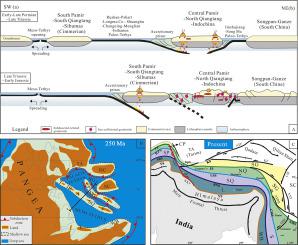Our official English website, www.x-mol.net, welcomes your
feedback! (Note: you will need to create a separate account there.)
Rushan-Pshart Paleo-Tethyan suture deduced from geochronological, geochemical, and Sr-Nd-Hf isotopic characteristics of granitoids in Pamir
Lithos ( IF 2.9 ) Pub Date : 2020-07-01 , DOI: 10.1016/j.lithos.2020.105549 Shifeng Wang , Wenkun Tang , Yiduo Liu , Xinghong Liu , Xin Yao
Lithos ( IF 2.9 ) Pub Date : 2020-07-01 , DOI: 10.1016/j.lithos.2020.105549 Shifeng Wang , Wenkun Tang , Yiduo Liu , Xinghong Liu , Xin Yao

|
Abstract Correlation of blocks comprising the Pamir plateau with blocks in the Tibetan plateau is debated due to the complex tectonic history of amalgamated orogenic belts, followed by widespread Cenozoic intracontinental deformation within the Pamir plateau. Of particular interest is the Rushan-Pshart suture along the southern edge of the Central Pamir. It is uncertain if the suture zone is a Meso-Tethyan or a Paleo-Tethyan suture and if it is the western extension of the Bangong-Nujiang suture. This study presents new in-situ zircon U-Pb geochronology, whole-rock geochemistry, and Sr-Nd-Hf isotopes of three granitic plutons (Tahman, Tash, and Mingtie) along the southern edge of the Central Pamir block. Emplacement ages of the three plutons range from ~206 Ma to ~201 Ma. Samples from Tahman and Tash contain 67% to 76% SiO2, and yield A/CNK values between 0.92 and 1.17. They exhibit high LILE/HFSE ratios, negative Eu anomalies (Eu/Eu* = 0.41–0.77), pronounced negative Nb, Ta, P, and Ti anomalies, negative eNd(t) values (between −7.3 and −6.9), and negative zircon eHf(t) values (between −15.5 and −1.4). Geochemical data indicate that the Tahman and Tash samples represent metaluminous or peraluminous, I-type arc-related granitoids. The Tahman granites are inferred to have formed by partial melting of the Precambrian metaigneous and metasedimentary rocks in the lower crust, while the Tash pluton was formed by partial melting of the infracrustal medium-to-high K basaltic compositions within the garnet stability field of the lowermost crust. We suggest that these newly discovered Late Triassic granite plutons are related to the closure of the Rushan-Pshart suture. This is supported by recent geochronological, paleontological, and stratigraphic studies. Thus, the Rushan-Pshart suture is a Paleo-Tethyan suture. We further notice that the Central Pamir block is bounded by the Tanymas and Rushan-Pshart Paleo-Tethyan sutures to the north and south, respectively, which is structurally similar to the North Qiangtang and the Indochina blocks that are also bounded by two Paleo-Tethyan sutures from both sides. This indicates that the Central Pamir block is the western extension of the Tianshuihai-North Qiangtang block, both of which underwent oblique convergence during the closure of the Paleo-Tethys ocean.
中文翻译:

从帕米尔花岗岩年代学、地球化学和Sr-Nd-Hf同位素特征推导出乳山-普夏特古特提斯缝合带
摘要 由于混杂造山带的复杂构造历史,以及随后在帕米尔高原内广泛发生的新生代陆内变形,帕米尔高原地块与青藏高原地块的相关性存在争议。特别令人感兴趣的是沿中帕米尔高原南缘的 Rushan-Pshart 缝合线。目前尚不确定缝合带是中特提斯缝合带还是古特提斯缝合带,是否为班公-怒江缝合带的西延。本研究提供了新的原位锆石 U-Pb 年代学、全岩地球化学和三个花岗岩岩体(Tahman、Tash 和 Mingtie)的 Sr-Nd-Hf 同位素,沿中帕米尔地块的南部边缘。三个岩体的就位年龄范围从~206 Ma 到~201 Ma。来自 Tahman 和 Tash 的样品含有 67% 至 76% 的 SiO2,并产生介于 0.92 和 1.17 之间的 A/CNK 值。它们表现出高 LILE/HFSE 比率、负 Eu 异常 (Eu/Eu* = 0.41–0.77)、显着的负 Nb、Ta、P 和 Ti 异常、负 eNd(t) 值(介于 -7.3 和 -6.9 之间),以及负锆石 eHf(t) 值(介于 -15.5 和 -1.4 之间)。地球化学数据表明 Tahman 和 Tash 样品代表金属铝质或过铝质 I 型弧相关花岗岩。据推测,塔赫曼花岗岩是由下地壳中前寒武纪变火成岩和变沉积岩的部分熔融形成的,而塔什岩体则是由石榴石稳定场内的地壳中高钾玄武岩成分部分熔融形成的。最下层地壳。我们认为这些新发现的晚三叠世花岗岩岩体与乳山-普夏特缝合线的闭合有关。这得到了最近的地质年代学、古生物学和地层学研究的支持。因此,Rushan-Pshart 缝合线是古特提斯缝合线。我们进一步注意到,中帕米尔地块的北、南分别以 Tanymas 和 Rushan-Pshart 古特提斯缝合线为界,这与同样以两个古特提斯为界的北羌塘和印度支那地块结构相似。从两侧缝合。这表明帕米尔中部地块是天水海-北羌塘地块的西延部分,在古特提斯洋闭合期间发生了斜辐合。我们进一步注意到,中帕米尔地块的北、南分别以 Tanymas 和 Rushan-Pshart 古特提斯缝合线为界,这与同样以两个古特提斯为界的北羌塘和印度支那地块结构相似。从两侧缝合。这表明帕米尔中部地块是天水海-北羌塘地块的西延部分,在古特提斯洋闭合期间发生了斜辐合。我们进一步注意到,中帕米尔地块的北、南分别以 Tanymas 和 Rushan-Pshart 古特提斯缝合线为界,与同样以两个古特提斯为界的北羌塘和印度支那地块结构相似。从两侧缝合。这表明帕米尔中部地块是天水海-北羌塘地块的西延部分,在古特提斯洋闭合期间发生了斜辐合。
更新日期:2020-07-01
中文翻译:

从帕米尔花岗岩年代学、地球化学和Sr-Nd-Hf同位素特征推导出乳山-普夏特古特提斯缝合带
摘要 由于混杂造山带的复杂构造历史,以及随后在帕米尔高原内广泛发生的新生代陆内变形,帕米尔高原地块与青藏高原地块的相关性存在争议。特别令人感兴趣的是沿中帕米尔高原南缘的 Rushan-Pshart 缝合线。目前尚不确定缝合带是中特提斯缝合带还是古特提斯缝合带,是否为班公-怒江缝合带的西延。本研究提供了新的原位锆石 U-Pb 年代学、全岩地球化学和三个花岗岩岩体(Tahman、Tash 和 Mingtie)的 Sr-Nd-Hf 同位素,沿中帕米尔地块的南部边缘。三个岩体的就位年龄范围从~206 Ma 到~201 Ma。来自 Tahman 和 Tash 的样品含有 67% 至 76% 的 SiO2,并产生介于 0.92 和 1.17 之间的 A/CNK 值。它们表现出高 LILE/HFSE 比率、负 Eu 异常 (Eu/Eu* = 0.41–0.77)、显着的负 Nb、Ta、P 和 Ti 异常、负 eNd(t) 值(介于 -7.3 和 -6.9 之间),以及负锆石 eHf(t) 值(介于 -15.5 和 -1.4 之间)。地球化学数据表明 Tahman 和 Tash 样品代表金属铝质或过铝质 I 型弧相关花岗岩。据推测,塔赫曼花岗岩是由下地壳中前寒武纪变火成岩和变沉积岩的部分熔融形成的,而塔什岩体则是由石榴石稳定场内的地壳中高钾玄武岩成分部分熔融形成的。最下层地壳。我们认为这些新发现的晚三叠世花岗岩岩体与乳山-普夏特缝合线的闭合有关。这得到了最近的地质年代学、古生物学和地层学研究的支持。因此,Rushan-Pshart 缝合线是古特提斯缝合线。我们进一步注意到,中帕米尔地块的北、南分别以 Tanymas 和 Rushan-Pshart 古特提斯缝合线为界,这与同样以两个古特提斯为界的北羌塘和印度支那地块结构相似。从两侧缝合。这表明帕米尔中部地块是天水海-北羌塘地块的西延部分,在古特提斯洋闭合期间发生了斜辐合。我们进一步注意到,中帕米尔地块的北、南分别以 Tanymas 和 Rushan-Pshart 古特提斯缝合线为界,这与同样以两个古特提斯为界的北羌塘和印度支那地块结构相似。从两侧缝合。这表明帕米尔中部地块是天水海-北羌塘地块的西延部分,在古特提斯洋闭合期间发生了斜辐合。我们进一步注意到,中帕米尔地块的北、南分别以 Tanymas 和 Rushan-Pshart 古特提斯缝合线为界,与同样以两个古特提斯为界的北羌塘和印度支那地块结构相似。从两侧缝合。这表明帕米尔中部地块是天水海-北羌塘地块的西延部分,在古特提斯洋闭合期间发生了斜辐合。











































 京公网安备 11010802027423号
京公网安备 11010802027423号